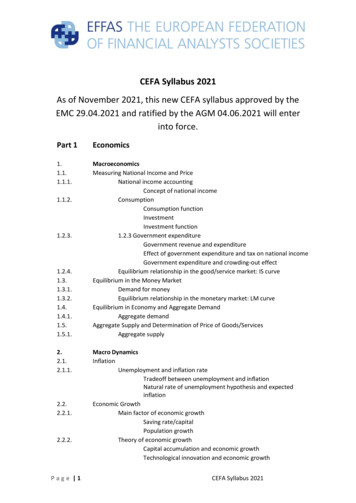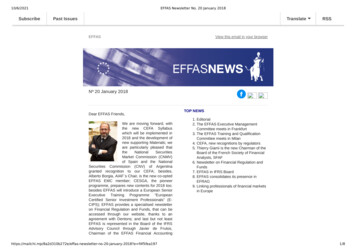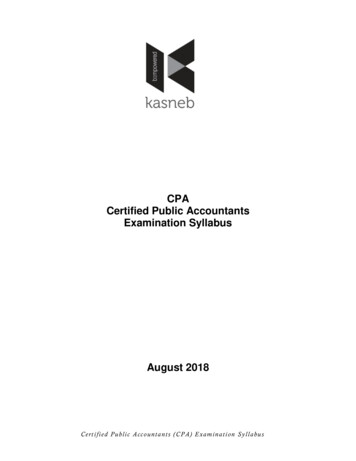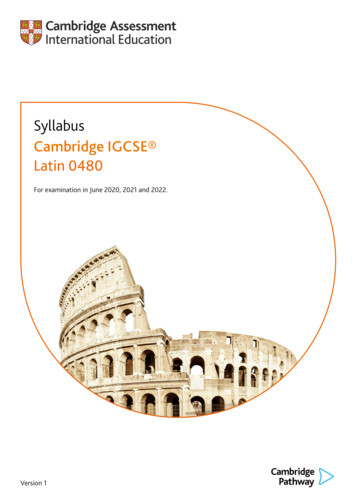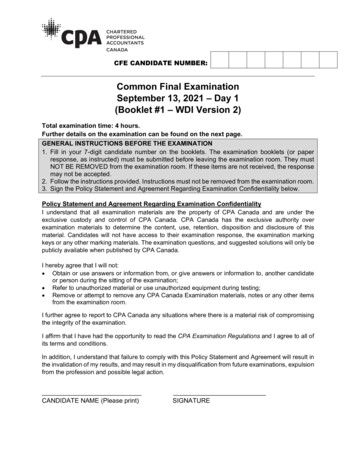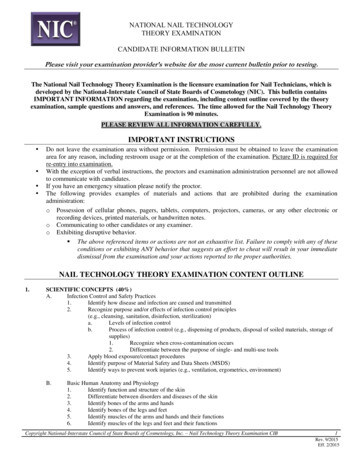
Transcription
CEFA Examination Syllabus 20211 Page
CEFACertified European Financial AnalystExamination SyllabusPageList of ContentsIndex1. Economics22. Corporate Finance53. Financial Accounting and Financial Statement Analysis84. Equity Valuation and Analysis135. Derivatives Valuation and Analysis146. Fixed Income Valuation and Analysis177. Portfolio Management218. European Regulation279. Ethics2810. ESG – Environmental Social and Governance2911. National Component28CEFA Examination Syllabus 20212 Page
Part 1Economics1.1.1.1.1.1.MacroeconomicsMeasuring National Income and PriceNational income accountingConcept of national incomeConsumptionConsumption functionInvestmentInvestment functionGovernment expenditureGovernment revenue and expenditureEffect of government expenditure and tax on national incomeGovernment expenditure and crowding-out effectEquilibrium relationship in the good/service market: IS curveEquilibrium in the Money MarketDemand for moneyEquilibrium relationship in the monetary market: LM curveEquilibrium in Economy and Aggregate DemandAggregate demandAggregate Supply and Determination of Price of Goods/ServicesAggregate 3.2.2.3.3.Macro DynamicsInflationUnemployment and inflation rateTradeoff between unemployment and inflationNatural rate of unemployment hypothesis and expectedinflationEconomic GrowthMain factor of economic growthSaving rate/capitalPopulation growthTheory of economic growthCapital accumulation and economic growthTechnological innovation and economic growthHuman resources and economic growthFinancial market and economic growthBusiness CyclesTheory of exogenous business cycleTheory of endogenous business cycleFiscal/monetary policy and business cycleCEFA Examination Syllabus 20213 Page
5.3.3.3.3.1.3.3.2.3.3.3.3.3.4.International Economy and Foreign Exchange MarketOpen MacroeconomicsInternational balance of payments and capital flowsBalance of payment statementBalance of payment and capital flowsFactor affecting international capital movementGovernment’s intervention and money supplyDetermination of equilibrium national income in the open economyForeign trade multiplier under floating systemOpen macro economics model: preliminaryEquilibrium model of open economyEffect of fiscal policyEffect of monetary policyForeign exchange rateDeterminants of exchange rate in the long-runConcept of foreign exchange ratePrice and foreign exchange rateInterest rate and foreign exchange rateDetermination of foreign exchange ratesMonetary approachAsset approachOvershooting modelPortfolio balance approach3.2.3 Government intervention and foreign exchange policyGovernment interventionForeign exchange rate and foreign exchange policy in localmarket3.2.4 Foreign exchange risk and risk managementRisk hedging with currency derivativesGrowth of currency derivatives marketsHistorical movement and forecasting of foreign exchange rateHistorical analysis of foreign exchange rateForecasting of foreign exchange rateImpact of foreign exchange rate change on security pricesCentral bank and monetary policyMonetary policyTarget of monetary policyInstruments of monetary policyTransmission effect of monetary policy on real economyCentral bank operations in major countriesEffect of monetary policy on security marketsCEFA Examination Syllabus 20214 Page
Part 2Corporate Finance1.1.1.1.1.1.1.1.2.Fundamentals of Corporate FinanceGoals of Corporate FinanceValue maximisation of shareholdersCorporate Governance issueAgency relationshipControl of the firmThe Finance Function and the Firm’s ObjectivesRole of Financial ManagersPrinciples of ValuationWhat is value?The valuation processValue creation for shareholdersDiscounted Cash FlowsWhat is cash flow?Basics of cash flow analysisTerminal valuesCapital BudgetingInvestment decision criteriaPayback rulesDiscounting payback period methodIRRNPVCost of capitalCost of equity capitalCost of debt capitalWACCCorporate taxes, interest subsidy and cost of capitalCAPMMeasuring betaCertainty equivalentsRisk free rateRisk adjusted discount .2.2.2.2.2.1.Long-Term Finance DecisionInvestment DecisionPeriodic budgetingProject evaluationProject EvaluationMethod for ranking investment proposalsCEFA Examination Syllabus 20215 Page
2.2.2.2.2.3.2.3.Capital resource rationingCommon pitfalls (e.g., Sunk costs, depreciation)Liquidation and Reorganisation3.3.1.3.1.1.Short-Term Finance DecisionShort-Term FinancingCurrent asset financingNeeds for working capitalComponents of working capitalShort term financingShort-term financing resourcesShort-term financial planning modelsCash ManagementCredit managementCommercial credit instrumentsCredit decisionCash managementTarget cash balance modelCash conversion cycleInvesting idle cash balanceShort-Term Lending and BorrowingShort-term lendingMoney marketsAlternatives to money marketsShort-term borrowingCredit rationingSecured and unsecured .4.2.6.Capital Structure and Dividend PolicyLeverage and the Value of the FirmModigliani-Miller Theory1) Irrelevance Theorem2) Corporate taxes and capital structureBankruptcy cost modelAgency cost modelDividend PolicyTypes of dividends (cash dividend, stock dividend, andsplits)Repurchase of stockIrrelevance TheoremClientele effectSignalling modelDividend policy in local marketCEFA Examination Syllabus 20216 Page
5.3.2.5.3.3.5.3.4.5.4.5.4.1.5.4.2.5.4.3.Mergers and AcquisitionsValuation IssuesValuation of the targetForms of AcquisitionsTake-oversApproved acquisitionsCreeping take-oversEliminating minority interestsStrategies for the AcquirerAggressive or agreedConditional or unconditionalTimingBoard considerationsDefensive StrategiesPre-emptive versus reactivePre-emptive (long-term) strategiesPre-emptive (short-term) 6.2.3.6.2.4.6.2.5.International Corporate FinanceInternational Capital Budgeting for Multinational FirmForeign project appraisalPolitical risk analysisManaging foreign exchange exposureAsset and Project FinanceAsset-backed securitiesLeasingProject evaluationLender's evaluation of the projectSyndicationCEFA Examination Syllabus 20217 Page
Part 3Financial Accounting and Financial Statement Analysis1.1.1.1.1.1.1.1.2.Financial Reporting EnvironmentFinancial StatementsBalance sheetIncome statementPresentation formatsClassification of expenses (by nature or by function)Statement of cash flowsStatement of changes in equityThe comprehensive incomeNotes to financial StatementsRelation between business activities and financial statementsFinancial Reporting IssuesUses of financial statementsEquity investmentCredit extensionCompetitionMerger & AcquisitionInternational differences in accountingInternational differences in accountingMarket – oriented accounting systemsBank – oriented accounting systemsThe IASB and the .2.2.2.3.2.4.Framework for the Preparation and Presentation of Financial StatementsObjective of financial statementsAccounting conventions (going concern, accrual Basis, etc)Criteria for accounting recognitionFundamental definitions (asset, liability, equity, revenue, expense)3.3.1.3.2.3.3.3.3.1.3.3.2.The cash flow statementRationale for the Statement of Cash FlowsRelation between Income Flows and Cash FlowsPresentation of the cash flow statementThe direct methodThe indirect method4.4.1.4.1.1.4.1.2.4.2.The income statement: Revenue recognitionCriteria for revenues recognitionSales of goodsRendering of servicesMeasurement of revenuesCEFA Examination Syllabus 20218 Page
4.3.4.3.1.4.3.2.4.4.4.4.1.4.4.2.4.4.3.Construction contractsPercentage of completion methodCompleted contract methodAccounting for stock – options and similar benefitsClassification of sharebased paymentsEquity – settled sharebased paymentsCash-settled sharebased payments5.5.1.5.1.1.Assets, Liabilities and Shareholders EquityAssetsProperty, plant and equipmentMeasurement at costMeasurement at fair valueInvestment propertyMeasurement at costMeasurement at fair valueIntangible assetsCriteria for recognitionAccounting for research and development costsInventoriesMeasurementCost formulas(FIFO, LIFO, weighted average Cost)Financial instrumentsClassificationMeasurement at fair valueMeasurement at amortized costHedge accountingImpairment of assetsMeasuring the recoverable amountImpairment testsLiabilitiesBondsAccounting for bond discounts/premiumsHybrid securitiesConvertible debt securitiesDebt issues with detachable warrantsLeasesOperating leasesFinance leasesBorrowing costsConditions for capitalizationCosts that may be capitalizedRetirement 2.2.5.2.3.5.2.4.5.2.5.CEFA Examination Syllabus 20219 Page
1.6.1.1.PensionsPost-retirement benefits other than pensionsIncome TaxesTemporary differencesDeferred taxesProvisionsConditions for the recognition of provisionsContingent liabilitiesShareholders’ EquitiesIssuance of capital stockAcquisition and reissue of treasury stocksCash, property and stock dividendsAccountingOther changes in retained 2.7.Business CombinationMergers and AcquisitionsAcquisitionsAsset valuation in acquisitionsAccounting for goodwillMergersPooling of interests methodPurchase methodConsolidated Financial StatementsThe scope of consolidationConsolidation methodsThe difference arising from consolidationUses of each methodThe consolidation procedureAnalysis of the difference arising from initial consolidationImpairment of reign Currency TransactionsForeign Currency TransactionInitial recognitionReporting at subsequent B/S dailyRecognition of exchange differencesFinancial Statements of Foreign OperationsClassification of foreign operationsTranslation to the presentation currency8.8.1.Financial Reporting and Financial Statement AnalysisIncome Flow vs Cash Flow6.1.2.CEFA Examination Syllabus 202110 P a g e
8.4.2.8.4.3.8.5.Relation between net income and cash flows from operatingactivitiesNet income and cash flows in various stages of life cycleQuality of Earning, Earnings ManagementData issues in analyzing financial statementsNon-recurring income itemsIncome, gains and losses from discontinued operationsAccounting changesChanges in accounting estimatesChanges in accounting policiesAdjustments to prior financial statementsEarnings per ShareBasic earnings per shareDiluted earnings per shareUsing EPS to value firmsCriticisms of EPSSegment ReportingDefinitionIndustry segmentsGeographical segmentsDisclosure requirementsUsing segment informationInterim Financial ical Tools for Gaining Financial Statement InsightsBalance SheetCommon size analysisTime series analysisIncome StatementCommon size analysisTime series analysis10.10.1.10.1.1.Analytical Tools for Assessing Profitability and RiskProfitability AnalysisROABreakdown of ROAInterpreting ROAROCERelating ROA to ROCEBreakdown of ROCERisk AnalysisShort term liquidity riskCurrent .3.3.8.3.4.8.4.8.4.1.10.1.2.10.2.10.2.1.CEFA Examination Syllabus 202111 P a g e
10.2.2.10.2.3.10.3.10.4.10.4.1.10.4.2.Quick ratioOperating cash flow to current liabilitiesWorking capital activity ratioOperating cash flow to cash interest costLong term solvency riskDebt ratioInterest coverage ratioOperating cash flow to total liabilitiesOperating cash flow to capital expenditureFinancial distress riskUnivariate analysisMultiple discriminant analysisBreak-even AnalysisPro Forma Financial StatementsSteps in preparing pro forma financial statementsConditions when common size percentage, growth rates, andturnover provide the best projections of financial statementsamountsCEFA Examination Syllabus 202112 P a g e
Part 4Equity Valuation and Analysis1.1.1.1.2.Equity Markets and StructuresTypes of equity securitiesCommon stockPreferred stockEquity mutual fund shares1.2. Indices2.Understanding the Industry Life Cycle3.3.1.3.2.3.3.3.4.3.5.3.6.3.7.Analysing the Industry Sector and its ConstituentCompaniesThe industry sectorCharacteristic of the industryMacro factorForecasting for companies in the sectorBalance sheet factorsCorporate ing the CompanyHistorical financial performanceSegmental informationInventory, debtors and creditorsDepreciation and amortisationCompleting the .5.4.2.5.4.3.5.4.4.Valuation Model of Common StockDividend discount modelZero-growth modelConstant growth modelMultiple growth modelFree cash flow modelEVA, MVA, CFROI, Abnormal earnings discount modelMeasures of relative valuePrice/earnings ratioPrice/book value ratioPrice/cash flow ratioPrice/sales ratioCEFA Examination Syllabus 202113 P a g e
Part 5Derivative Valuation and Analysis1.1.1.1.1.1.Financial Markets and InstrumentsDerivatives MarketsFixed income derivativesInterest rate optionsInterest rate futuresDelivery optionsConversion factorsCheapest-to-deliver bondsCustom interest rate agreements (interest swap, IRA, cap, floor and swaptions)Equity derivativesOptions on individual stocksStock index futures and optionsFutures MarketsBasic characteristics of futures contractMechanics of trading in futures marketsRelated MarketsSwapsCharacteristics of swapsRelated products (IRA, cap, floor, swaptions)Credit derivatives: Market, instruments, and general characteristicsMarket of credit derivativesDefinition of credit default swaps (CDS)Structural diagram of credit default swapsCredit eventsPhysical settlementCash settlementTrigger eventsCDS productsCredit default swaps and credit linked notesIndex productsOther credit default swap productsThe role of credit derivativesIsolating credit riskEfficient mechanism to short a creditMarket for pure credit risksLiquidity provision in times of turbulenceTailor credit investments and hedgesConfidential transactionsMarket participantsBank and loan portfolio 1.4.4.1.4.5.1.4.6.1.4.7.CEFA Examination Syllabus 202114 P a g e
.1.5.2.2.2.2.1.2.2.2.2.2.3.Market makersHedge fundsAsset managersInsurance companiesCorporationsInstitutional frameworkMarking to marketStandardised documentationCounterparty considerationSpread volatility of credit default swapsCredit derivatives: valuation of credit default swapsCreating synthetic CDSValuation of credit default swaps by a non-arbitrage approachEstimating default probabilitiesAnalysis of derivatives and other productsFuturesFactors determining contract priceTheoretical price of futuresBasis and factors causing changeArbitrage problemsHedging strategiesThe hedge ratioThe perfect hedgeMinimum variance hedge ratioHedging with several futures contractsOptionsDeterminants of option priceOptions pricing modelsB&S option pricing formula and variantsEuropean options on stocks paying known dividendsEuropean options on stocks paying unknown dividendsAmerican options on stocks paying known dividendsOptions on stock indicesOptions on futuresOptions on currenciesWarrantsBinomial option pricing model2.2.3 Sensitivity analysis of optionsPremiumsThe strike pricePrice of underlying assets, and delta and gammaThe time to maturity and thetaCEFA Examination Syllabus 202115 P a g e
rest rate and rhoVolatility of the stock returns and vegaVolatility and related topicsEstimating volatility from historical dataImplied volatility and volatility smileExotic optionsOptions strategiesCovered callProtective putSpreadsStraddlesStranglesAsset-backed SecuritiesTypes of underlying assetsInstalment contractRevolving lines of creditOther assetsCash flow characteristicsCredit enhancementValuation methodologiesCEFA Examination Syllabus 202116 P a g e
Part 6Fixed Income Valuation and Analysis1.1.2.1.2.1.Financial Markets and InstrumentsFixed Income: Corporate and GovernmentTypes of fixed income securitiesMoney market instrumentsGovernment bondsCorporate .1.2.3.2.2.3.3.Time Value of MoneyTime value of moneySimple versus compound interestPresent and future valueAnnuitiesContinuous discounting and compoundingBond Yield MeasuresYield vs discountCurrent yieldYield to maturityYield to callOther basic conceptsSpot ratesDiscount functionForward ratesRelations between spot rate, forward rate and the slope of the termstructureYield curvesMarket Curves (Observed)YieldSwapsCreditTheoretical Curves (Imputed)Term StructuresParametric modellingTerm Structure of Interest RatesYield curves and shapesTheories of term structureExpectations hypothesisLiquidity preferencesMarket segmentation and preferred habitat theoriesTerm structuresRisk ManagementCEFA Examination Syllabus 202117 P a g e
7.1.2.7.2.2.7.3.2.7.4.Asset Management/Liability Management/ALMFinancial EngineeringStructured ProductsRegulatoryPortfolio ValuationMark-to-Mark with Unobserved PricesBond Price AnalysisBasic price/yield relationshipYield spread analysisTypes of spreadsDeterminants of yield spreadsValuation of coupon bonds using zero-coupon pricesStatic arbitrage and valuation of coupon bondsStrips marketsRisk MeasurementRisk measurement toolsDuration and modified durationConvexityHedgingUsageBond Yield CurvesZero (Spot), Coupon and Par curvesBond Curves in Market UsageStructure and SmoothnessTrade Horizon: Yield, Duration & ConvexityReversion to MeanCurve Shapes and Future RatesConstraints: Absolute & Relative (Slope)Negative Discount FunctionCurves and Economic ActivityCurves and Monetary PolicyOther CurvesSwap CurvesCredit CurvesSpread CurvesCredit RiskIndustry considerationRatio analysisCredit rating and rating agenciesCurves and creditThe Additional Dimensions of CreditDefault riskCEFA Examination Syllabus 202118 P a g e
Recovery RatesAnnualised Expected Loss RatesBankruptcy processesTerm Structure of CreditCredit Default Swaps (CDS)Curve Shapes and Credit QualityHistorical Behaviour: Curves Under Shock3.3.1.3.2.Bonds with WarrantsInvestment CharacteristicsValue of Warrants4.4.1.4.2.Convertible BondsInvestment CharacteristicsValue of Conversion llable BondsInvestment CharacteristicsPrice-yield relationship for a callable bondNegative convexityValuation and DurationDetermining the call option valueOption-adjusted spreadEffective duration and convexity6.6.1.6.2.Floating Rate NotesInvestment Characteristics and TypesValuation 7.3.2.7.3.3.7.3.4.7.3.5.7.3.6.Mortgage-Backed SecuritiesTypes of MortgagesLevel-payment fixed-rateAdjustable-rate (ARM)Types of SecuritiesPass-through securitiesCollateralised mortgage obligationsFactors Affecting Market PriceUnderlying collateralStructure and seasoningPrepayment rateLevel of interest rateLiquidityCredit riskCEFA Examination Syllabus 202119 P a g e
7.4.7.4.1.7.4.2.Valuation MethodologiesStatic cash flow yield methodologyPrepayment .8.2.4.8.3.8.3.1.8.3.2.8.3.3.8.4.Fixed Income Portfolio Management StrategiesActive ManagementInterest rate anticipation strategiesYield spread analysisMaturity spacing strategiesPassive ManagementBuy and holdIndexationImmunisationCash flow matchingPortfolio Construction based on a Factor ModelModel specificationSuitable factors such as interest rates, spreadsManaging factor sensitivitiesComputing the Hedge Ratio: the Modified Duration MethodCEFA Examination Syllabus 202120 P a g e
Part 7Portfolio 5.1.1.5.2.1.5.3.1.5.4.Modern Portfolio TheoryThe Risk/Return FrameworkReturnMeasures of returnRiskComponents of total riskMeasures of riskMeasuresValue at riskEfficient Market HypothesisDefinition & assumptionsAlternative hypothesisTypes of market efficiencyMarket anomaliesPortfolio TheoryDiversification and portfolio riskMarkowitz model and efficient frontierCapital Asset Pricing Model (CAPM) - building on fundamentals in Part 2 module 1.6.3Major assumptionsCapital market line (CML)Security market line (SML)International CAPMArbitrage Pricing TheoryAssumptionsOne factor modelsMulti-factor modelsArbitrage pricing theory2.2.1.2.1.1.2.1.2.2.1.3.Investment PolicyInvestment ObjectivesSetting investment objectives for individualsDeciding portfolio structureSetting objectives for set AllocationAsset Allocation OverviewWhat is asset allocation?Who does asset allocation?Implementing and managing the asset allocation processEvolution of asset allocationCapital Market Expectations1.1.2.1.1.3.CEFA Examination Syllabus 202121 P a g e
3.2.3.2.1.3.2.2.3.2.3.3.2.4.Type of Asset AllocationIntegrated asset allocationStrategic asset allocationTactical asset allocationDynamic asset set Liability-Analysis and ManagementIntroductionBackground of ALMALM with pension fundsTypes of ALM modelsModelling LiabilitiesTypes of liabilitiesValuation of pension liabilitiesAnnuity factors and discount ratesModelling AssetsTypes of asset classesRisk and return characteristicsFunding RatiosDefinitionsSurplus risk managementIntegrated OptimisationStochastic simulationTarget functions and trade offsScenario analysis and stress testingImplementation of strategiesActive versus passive ALM strategiesDynamics adjustment of assets and liabilitiesDynamics and ImplementationDynamic adjustment of liabilitiesDynamic asset allocation and rebalancingLiability driven investing5.5.1.5.1.1.Practical Portfolio ManagementManaging an Equity PortfolioActive managementTechnical analysis/market timingStock selection/industry selectionselectionGrowth/value -upCEFA Examination Syllabus 202122 P a g e
justing the beta of an equity portfolioPassive managementBuy and holdStock index fundsCustomised fundsCompleteness fundsFactor/style fundsIndexing technologyBenchmark choiceChoice of the tracking errorCombined strategiesActive/passive combinationsPortfolio construction based on a factor modelDerivatives in Portfolio ManagementCombining options and traditional assetsPortfolio insuranceStatic portfolio insuranceDynamic portfolio insuranceConstant Proportion Portfolio InsuranceHedging with stock index futuresHedging with foreign exchange futuresHedging with interest rate futuresUse of swaps in portfolio managementAsset allocation with futuresManaging a Property PortfolioThe role of property in a diversified portfolioThe property investment decisionMicroeconomic influences on property returnsMacroeconomic influences on property returnsDifference property investmentsAlternative Assets/Private CapitalUnlisted (non-property) securitiesTerms, conditions, and characteristicsRole in a traditional portfolioManaging unlisted security vehiclesMonitoring and reportingInternational InvestmentsInternational diversificationCross-correlationsCountry riskEmerging marketsHedging foreign exchange riskEffective management of currency riskCEFA Examination Syllabus 202123 P a g e
r of currency returnsIs it a separate asset class / zero sum game?Treatment of currency within a portfolioBlack's paper on universal currency hedgeUse of overlay strategiesKey sensitivitiesCurrency-related example of performance attributionInternational equitiesReasons for holding international equity assetsPerformance objectivesInternational fixed incomeReasons for holding international fixed interest assetsPerformance objectivesManaging a portfolio of international assetsInternational investingGlobal asset allocationPortfolio management stylesPortfolio constructionPortfolio management strategyPerformance MeasurementPerformance Measurement and EvaluationsRisk-return measurementMarket and book value evaluationTime horizon and performance measurementInflow/outflow of cash and performance measurementTime-weighted and dollar weighted rate of returnRisk-adjusted performance measuresSharpe's measureTreynor's measureJensen's alphaAppraisal ratioRelative investment performanceManager-universe comparisonIndices and benchmarksIndex definition and calculationChoosing and constructing a benchmarkDomestic vs. International benchmarksCash benchmark and currenciesMulti-currency investments and interest rate differentialsCurrency overlay and performance measurementBalanced benchmarksRandom and normal portfoliosCEFA Examination Syllabus 202124 P a g e
6.1.4.6.1.5.Index vs. universe medianStyle-bogey comparisonsPerformance attribution analysisAsset allocation effectIndustry selection effectSecurity selection effectInvestment timing effectAttribution analysis of fixed income portfolioSpecial issuesPerformance evaluation of international investmentsA single currency attribution model by Brinson & al.Multi-currency attribution and interest rate differentialsPerformance evaluation of international investments derivativeinvestmentsEffects of costs7.7.1.7.1.1.Management of Investment InstitutionsAssessing and Choosing ManagersStyle analysisMeans of style analysisStyle analysisRisks, controls and prudential issues: organisational issuesRisks, controls and prudential issues: fee 5.4.8.6.Behavioural FinanceDefinition and scope of Behavioural FinanceRationality (homo oeconomicus) versus Bounded Rationality (according to Herbert Simon)Anomalies in human behaviourAnomalies regarding perception of informationAnomalies regarding information processingAnomalies regarding decision makingHeuristicsSimplification heuristicMental accountingAvailability heuristicAnchoringRepresentativityProspect TheoryValue functionAsymmetry effectDisposition effectReference pointsLoss aversionCEFA Examination Syllabus 202125 P a g e
8.7.8.8.8.9.8.10.Regret aversionFramingOverconfidenceHome biasPart 8: European Regulation (EFFAS Manual)Chapter I: European Legal Framework for Financial Services0.Why regulation?1.European Legislation1.1.A brief history of European Union1.2.Enlargement1.3.Decision-Making Bodies1.3.1.The European Parliament1.3.2.The Council of the European Union1.3.3.The EU Commission1.4.Legislative DirectivesRegulationsDecisionsNational Implementing MeasuresLegislative ProcedureCo-Decision ProcedureComitology Procedure (Lamfalussy Process)The Single Market for financial servicesThe four principles of General Freedom in the EU2.1.1.2.1.2.2.1.3.2.1.4.2.2.Free Movement of PeopleFree Movement of GoodsFree Movement of ServicesFree Movement of CapitalHarmonisation of Legislation2.2.1.2.2.2.2.2.3.2.3.2.4.Minimum harmonisationMaximum harmonisationHarmonisation via regulationsFSAP Financial Services Action PlanSingle Market Act3.3.1.3.1.1.3.1.2.Regulation of Capital MarketsMarket in Financial Instruments Directive (MiFID II / MiFIR)Guiding PrinciplesRules of ConductCEFA Examination Syllabus 202126 P a g e
3.2.Market Abuse Directive (MAD II / 5.3.6.3.7.3.8.3.9.3.10.3.11.3.12.3.13.Insider TransactionsMarket ManipulationManipulative deals and ordersDeals and orders with accompanying manipulative actionsManipulative informationDirective on Takeover BidsProspectus DirectiveTransparency DirectiveEMIR European Market Infrastructure RegulationRegulation on Investment Funds (UCITS)Alternative Investment Fund Managers Directive (AIFMD)Regulation on Credit Rating AgenciesInvestor compensation schemesAnti-Money Laundering DirectiveRegulation on PRIIPSNew Investment vehiclesChapter II: European Supervision of Capital Markets4.European Regulatory Bodies4.1.Old Supervisory Architecture4.1.1.National Supervisory Authorities4.1.2.EU Committees4.1.2.1.Committee of Banking Supervisors (CEBS)Committee of Insurance and Occupational e of Securities Regulators (CESR)4.1.2.4.Colleges of Supervisors4.2.New Supervisory 3.4.4.European Systemic Risk Board (ESRB)European System of Financial SupervisorsEuropean Banking Authority (EBA)European Insurance and Occupational Pensions Authority(EIOPA)European Securities and Markets Authority (ESMA)Banking UnionCapital Markets UnionCEFA Examination Syllabus 202127 P a g e
Part 9: Ethics1.1.1.1.2.1.3.1.4.Ethical ConductWhy ethical behaviour in financial markets?The 'client first' principleConflicts of interestMarket Abuse (insider trading, market manipulation)2.Self-Regulation and Ethical .3.IOSCOBasel Committee for Banking SupervisionCorporate Governance & ComplianceCorporate Governance CodesStandard Compliance CodesCode of Ethics for Financial AnalystsEFFAS Principles of Ethical ConductPractical case studies on 1.2 to 1.4.ACIIA Principles of Ethical Conduct(overview)AnnexEFFAS Princ
CEFA Examination Syllabus 2021 4 P a g e 3. International Economy and Foreign Exchange Market 3.1. Open Macroeconomics 3.1.1. International balance of payments and capital flows Balance of payment statement Balance of payment and capital flows Factor affecting international capital movement Government's intervention and money supply 3.1.2.
